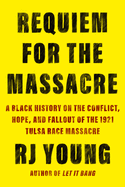
In 1921, white Tulsans burned the prosperous Black business district of Greenwood to the ground, based on shaky allegations against a young Black man. In his powerful second nonfiction book, Requiem for the Massacre, sportswriter and longtime Tulsan RJ Young (Let It Bang) investigates the century-long fallout from the massacre and calls his hometown to account for its consistent devaluing of Black lives. Young, drawing on eyewitness accounts and other historical resources, opens with a detailed recounting of the massacre itself. He dives deeply into the origins of the phrase "Black Wall Street," still a common moniker for Greenwood. Young also traces his experiences as a teenager, college student and sportswriting professional in Tulsa, a town that often ignores or blatantly antagonizes its Black residents. The book's second half chronicles Young's journey to events commemorating the centennial of the massacre, which take place during racial unrest catalyzed by George Floyd's murder and the Covid-19 pandemic.
Young's clear-eyed, first-person narration blazes from the page: he explores the deeply complicated reality of being a Black man who owns property in a city, state and country that has often tried to prevent just that. He ties the Greenwood massacre and Tulsa's racism to the broader legacy of anti-Blackness in the U.S. and asks pointed questions about reparations, honest commemoration and true apologies. Unsettling, fierce and necessary, Requiem for the Massacre is a vital primer on a slice of American history that has been hidden for too long. --Katie Noah Gibson, blogger at Cakes, Tea and Dreams

